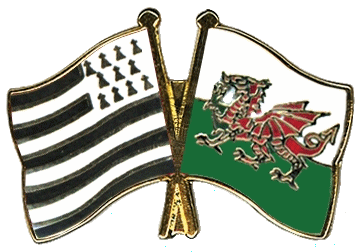
Wales and Brittany
Natural twins
Lots of twinning associations local to us are twinned with towns in Brittany. Is this coincidence, or just laziness as it's one of the closest parts of France? No – close it may be, but modern travel links make it quicker to get to other parts of France than to Brittany. It’s likely that there is a natural affinity between the Welsh and the Bretons. Just as the Welsh see themselves as Welsh first, then British, so the Bretons see themselves as primarily Breton, albeit still part of France. Perhaps this common independent nature can trace its origins to a common ancestry in the Britons, who were driven out of England by the Saxons and Angles into Wales (and Cornwall), and out of Northern France into Brittany by the Normans.
The languages
English
Good
Good day
Apple
Good health (cheers)
Low
Bad
Happy, merry
Old
Welsh
Da
Bore da
Afal
Ieched da
Isel
Drwg
Llawen
Hen
Breton
Mat
Demat
Aval
Yec'hed mat
Izel
Drouk
Laouen
Hen
French
Bon
Bonjour
Pomme
Salut
Bas
Mauvais
Joyeux
Vieux
The languages also have much in common. Along with Cornish (also Britons), Welsh and Breton make up the 3 Brythonic Celtic languages, as distinct from Irish, Scottish, and Manx, making up the Goidelic Celtic languages. There are some striking similarities in the languages spoken to this day – the Breton Flag is called Gwenn-ha-du (meaning white and black) – in Welsh this is Gwyn a du. Look below at some further examples of similar words and phrases. This is why Welsh and Breton speakers can sometimes understand each other better in their own language than when they try to speak French and English!
Common Anthems
The Welsh National Anthem is "Hen Wlad Fy Nhadau" (Land of my fathers). The words were written by Evan James and the tune composed by his son, James James in January 1856.
In 1897, Fanch Jaffrennou (or François Jaffrennou, also known as Taldir) was inspired by Hen Wlad Fy Nhadau and wrote a Breton version "Bro goz ma zadou" (Old Country of My Fathers), with an extra stanza. This was adopted as a Breton national song in 1903.
In 1905 "Hen Wlad Fy Nhadau" became the first National Anthem to be sung at the start of a sporting event (unsurprisingly a rugby match) as a response to the New Zealand haka. It slowly became adopted as the Welsh National Anthem after this, being fully adopted at sporting fixtures since 1975. Anyone who has seen a Welsh International rugby match recently will know that the tradition started in 1905 has continued with gusto!
The words to both anthems (with English translation beside) appear below. Click the link at the end to hear the anthems being sung.
Hen Wlad Fy Nhadau
Mae hen wlad fy nhadau yn annwyl i mi,
Gwlad beirdd a chantorion, enwogion o fri;
Ei gwrol ryfelwyr, gwladgarwyr tra mâd,
Tros ryddid gollasant eu gwaed.
cytgan
Gwlad, Gwlad, pleidiol wyf i'm gwlad,
Tra môr yn fur i'r bur hoff bau,
O bydded i'r hen iaith barhau.
Land of my Fathers
The old land of my fathers is dear to me,
Land of bards and singers, famous men of renown
Her brave warriors, great patriots,
For freedom shed their blood
chorus
Country, country, I am faithful to my Country,
While the sea is a wall for the pure, most loved land,
O may the old language endure.
Bro Goz Ma Zadou
Ni ’Breiziz a galon karomp hon gwir Vrô !
Brudet eo an Arvor dre ar bed tro-dro.
Dispont kreiz ar brezel, hon tadou ken mad,
A skuillaz eviti o gwad.
diskan :
O ma Mam-Vrô, me gar ma Bro,
Tra ma vô ar mor ’vel mur ’n he zro,
Ra vezo digabestr ma Bro !
Old Country of My Fathers
We Bretons of heart love our true country!
Armorica, famous throughout the world.
Bravely in the middle of the war, our father so good,
Shed their blood for you.
chorus :
O Brittany, my country, I love my country,
As long as the sea is like a rampart around her,
Shall my country be free!
The Welsh and Breton Flags
_svg_.png)
The Welsh Flag, “Y Ddraig Goch” (The Red Dragon), incorporates the red dragon of Cadwaladr, King of Gwynedd between 655 – 682 AD, along with the Tudor colours of green and white, and was used by Henry VII at the Battle of Bosworth in 1485. The red dragon has been associated with Wales for centuries, its origins now lost in history and myth. It features in stories in some old texts, including the Mabinogion, which recounts a fight between a red dragon, representing the native Britons (who became the Welsh), and a white dragon, representing the invading Saxons. King Arthur of legend is supposed to have carried a dragon banner, and a red dragon features on the flags of a number of historical kings including Owain Glyndŵr, and remains one of the Queen’s ten heraldic beasts.
The flag was granted official status in 1959, although the dragon is not standardised so you may see some slightly different versions being flown.
_sv.png)
The flag of Brittany is called the Gwenn-ha-du, meaning white and black in Breton. The flag was created in 1923 by Morvan Marchal, who was inspired by the United States of America Stars and Stripes, seen as a symbol of freedom. It is a regional rather than national flag, but is widely used throughout Brittany including on some official buildings.
The nine horizontal stripes represent the historic dioceses into which the duchy of Brittany was divided . The five black stripes represent the French speaking dioceses, and the four white stripes represent the Breton speaking dioceses. The ermine canton recalls the arms of the Duchy of Brittany.

